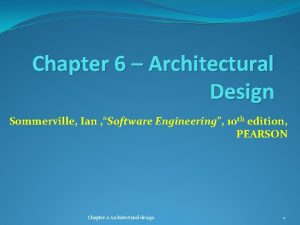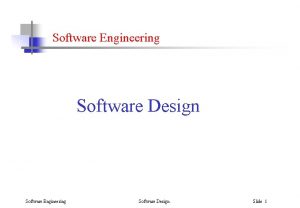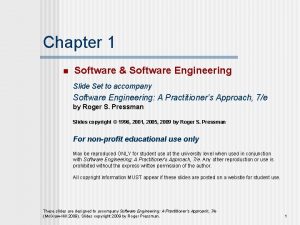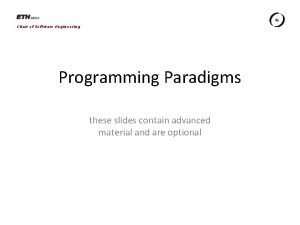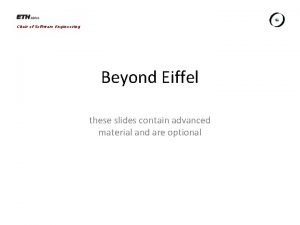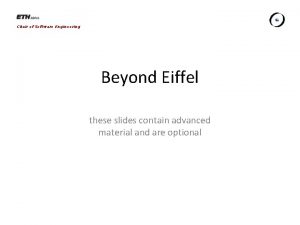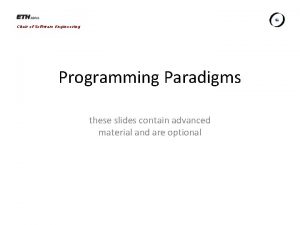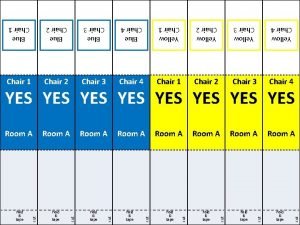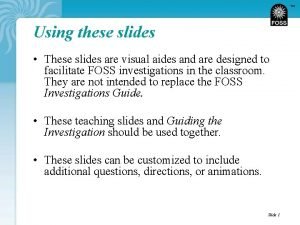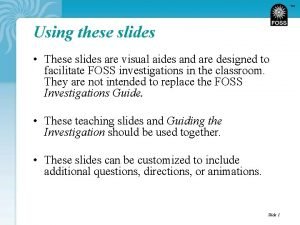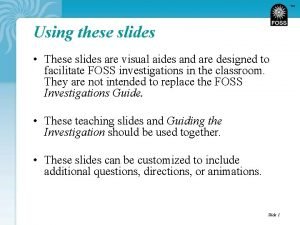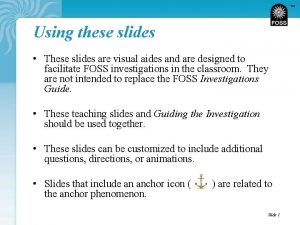Chair of Software Engineering Void safety these slides



















- Slides: 19

Chair of Software Engineering Void safety these slides contain advanced material and are optional

The inventor of null references I call it my billion-dollar mistake. It was the invention of the null reference in 1965. At that time, I was designing the first comprehensive type system for references in an object oriented language (ALGOL W). My goal was to ensure that all use of references should be absolutely safe, with checking performed automatically by the compiler. But I couldn't resist the temptation to put in a null reference, simply because it was so easy to implement. This has led to innumerable errors, vulnerabilities, and system crashes, which have probably caused a billion dollars of pain and damage in the last forty years. By Tony Hoare, 2009 2

Problems of void-calls • Entities are either – Attached: referencing a valid object – Detached: Void (or null) • Calls on detached entities cause a runtime error • Runtime errors are bad. . . How can we prevent this problem? 3

Solution to void-calls A call f. x (. . . ) is only allowed, if f is statically attached. • Statically attached: Checked at compile-time • Dynamically attached: Attached at runtime • Consistency: If f is statically attached, its possible runtime values are dynamically attached. 4

Statically attached entities • Attached types – Reference types that cannot be Void – x: attached STRING • Certified attachment patterns (CAP) – Code pattern where attachment is guaranteed – if x /= Void then x. f end (where x is a local) • Object test – Assign result of arbitrary expression to a local – Boolean value indicating if result is attached – if attached x as l then l. f end 5

Attached types • Can declare type of entities as attached or detachable – att: attached STRING – det: detachable STRING • Attached types – Can call features: att. to_upper – Can be assign to detachable: det : = att – Cannot be set to void: att : = Void • Detachable types – No feature calls: det. to_upper – Cannot be assign to attached: att : = det – Can be set to void: det : = Void 6

Attached types (cont. ) • Entities need to be initialized – Detachable: Void – Attached: assignment or creation • Initialization rules for attached types – Locals: before first use – Attributes: at end of each creation routine – Compiler uses control-flow analysis • Types without attachment mark – Default can be set in project settings – Default for void-safe projects should be attached 7

Attached types demo • • Eiffel. Studio settings Declarations Error messages Initialization 8

Certified attachment pattern (CAP) • Code patterns where attachment is guaranteed • Basic CAPs for locals and arguments – Void check in conditional or semi-strict operator – Setter or creation capitalize (a_string: detachable STRING) do if a_string /= Void then a_string. to_upper end ensure a_string /= Void implies a_string. is_upper end 9

CAP demo • Different CAPs for locals and arguments – – Void check in contract Void check in conditional Setter Creator 10

Object test • Checking attachment of an expression (and its type) • Assignment to a local variable – Local is not declared and only available in one branch name: detachable STRING capitalize_name do if attached name as l_name then l_name. to_upper end ensure attached name as n implies n. is_upper end 11

Side note on object tests • Object test can also be used to make a type cast • The test is True, if object conforms to specified type • Local variable will have specified type name: detachable ANY capitalize_name do if attached {STRING} name as l_name then l_name. to_upper end ensure attached {STRING} name as n implies n. is_upper end 12

Object test demo • Object test in body • Object test in assertion • Object test to test for type 13

Stable attributes • Detachable attributes which are never set to void • They are initially void, but once attached will stay so name: detachable STRING note option: stable attribute end capitalize_name do if name /= Void then name. to_upper end 14

Stable demo • Declaring stable attributes • CAPs with stable attributes 15

Arrays • Arrays can have more storage space then elements • Empty storage space filled with default values • What is the default for attached types? – a: attached ARRAY [attached STRING] • See Array demo 16

Other languages: Spec# • Research variant of C# • Adds contracts and non-null types (and more) • Non-null types are marked with ! String s = null; String! s = „abc“; String! s = null; 17

Other languages: JML • Research variant of Java • Adds contracts and non-null types (and more) • Types (except locals) are non-null per default String s = null; String s = „abc“; /*@ nullable @*/ String s = null; 18

References • Eiffel documentation on void-safety – http: //docs. eiffel. com/book/method/void-safe-programming-eiffel • Avoid a Void: The eradication of null dereferencing – http: //s. eiffel. com/void_safety_paper • Targeted expressions – http: //se. ethz. ch/~meyer/publications/online/targeted. pdf 19
 Void loop
Void loop Void main(void)
Void main(void) Void main(void)
Void main(void) Sommerville software engineering slides
Sommerville software engineering slides Design process in software engineering
Design process in software engineering Software engineering slides
Software engineering slides A small child slides down the four frictionless slides
A small child slides down the four frictionless slides Each of the boxes shown is pulled for 10 m
Each of the boxes shown is pulled for 10 m Chair inspection checklist
Chair inspection checklist System architecture example
System architecture example Forward engineering in software engineering
Forward engineering in software engineering These slides
These slides These slides
These slides Following slides
Following slides Software maintenance in software engineering ppt
Software maintenance in software engineering ppt Frank maurer
Frank maurer What is software metrics in software engineering
What is software metrics in software engineering Types of software crisis
Types of software crisis Software measurement and metrics in software engineering
Software measurement and metrics in software engineering Real time software design in software engineering
Real time software design in software engineering



